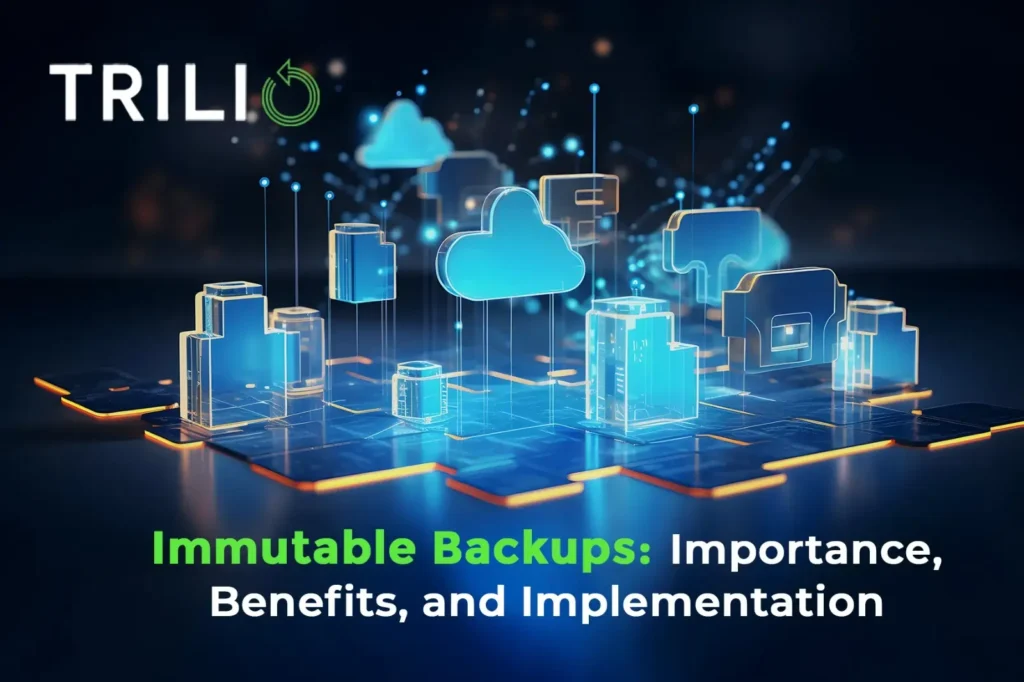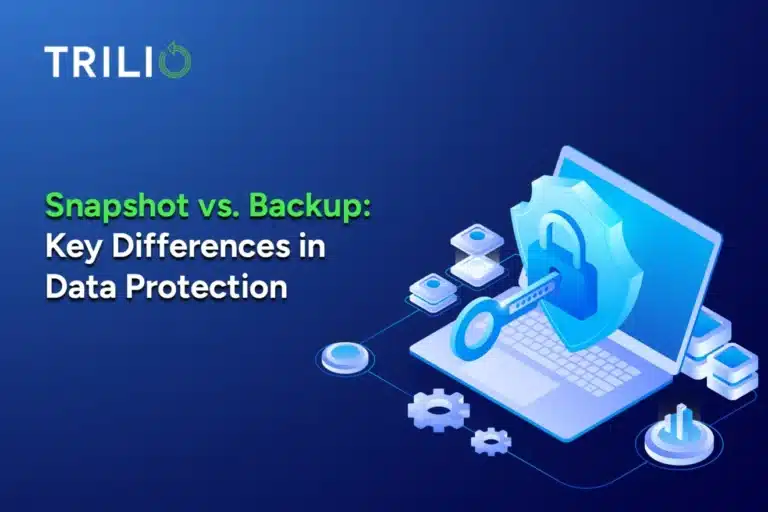Ransomware, human errors, and disasters are constant threats to your business’s most valuable asset –its data. Traditional backups, while essential, aren’t always enough since ransomware can still infiltrate them. That’s where immutable backups emerge as a crucial layer of protection. They ensure that even if the worst happens, your critical information remains untouched and recoverable. This article explains the fundamentals of immutable backups, their benefits, and provides a step-by-step guide on how to integrate them into your IT environment.
What Are Immutable Backups & Why Do They Matter?
Immutable backups are data copies that, once created, become unchangeable and undeletable for a set period. Think of them like a highly secure digital vault. Immutable backups use technologies like WORM (Write Once, Read Many) or object-locking in cloud systems to enforce this protection, ultimately giving you the peace of mind that data can be recovered even in worst-case scenarios. Additionally, immutable backups help companies achieve data security compliance since they store accurate, unalterable records of vital information.
Immutable Backups vs. Traditional Backups
If your organization currently relies solely on traditional (mutable) backups, you are at significant risk. Today’s cyberattacks are more sophisticated and destructive than ever before. Traditional backups can leave you vulnerable because they are susceptible to the same malware that attacks your primary systems. If your network is infiltrated and infected, your backups might also become compromised. Additionally, human error remains a factor. Traditional backups can be accidentally deleted or modified, hurting your recovery potential. Finally, ransomware is a top concern – this malicious software encrypts your data, making it inaccessible, with attackers demanding a ransom in exchange for a decryption key. Traditional backups are prime targets for ransomware attacks, since hackers know they’re crucial for recovery, leaving you with less leverage. Immutable backups directly address these vulnerabilities by ensuring your backups remain unchangeable and undeletable, guaranteeing recovery even if an attack occurs.
The Benefits of Immutable Backups
While resilience against ransomware is a critical benefit, immutable backups offer far more to your IT strategy:
- Data Integrity and Security: Immutable backups protect your data from both accidental and malicious modification, ensuring it remains accurate and safe.
- Data Corruption Prevention: Their unchangeable nature shields your backups from software failures, configuration errors, or other issues that could compromise traditional backups.
- Faster RTOs and Shorter RPOs: Minimize downtime with quick restoration from immutable backups, allowing you to resume operations quickly and maintain more frequent recovery points.
- Regulatory Compliance: Many regulations, like GDPR, HIPAA, and others, require specific data retention periods and emphasize data integrity. Immutable backups help demonstrate that your data is unalterable and stored securely for the required duration, facilitating compliance audits and minimizing the risk of costly fines.
- Forensic Analysis: When dealing with security incidents or legal disputes, having access to unmodified data is crucial. Immutable backups preserve a chain of custody, aiding in the investigation of root causes, determining the scope of potential breaches, and providing evidence when needed.
The Power of Combining Immutable and Traditional Backups
Adding a layer of immutability to your existing backup strategy significantly increases your chances of a successful recovery in the event of an attack or incident. Trilio’s recovery capabilities provide flexible ways to implement immutable backups:
- Two-Tiered Protection: Combine immutable and traditional backups for a comprehensive strategy. Immutable backups can become your primary line of defense for critical data, while traditional backups might serve as a secondary option for less critical datasets or development environments.
- Choosing Your Immutable Strategy: Trilio seamlessly integrates with object storage targets that have object locking and versioning enabled, like AWS S3, Wasabi or Minio. Configuring object locking is straightforward with Trilio and this safeguards your backups from modification or deletion. There are usually two modes of object locking, explained here:
- Governance Mode: Objects placed in Governance Mode remain immutable until after they have reached the retain until date, unless a user has specific IAM permissions to alter the settings.
- Compliance Mode: Objects placed in Compliance Mode remain immutable until after they have reached the retain until date. This cannot be reversed for any reason, by any user, regardless of user permissions. We strongly encourage you to configure your buckets in Compliance mode, unless for any reason you want someone with the right permissions to be able to delete the backups, or change their expiration date. Compliance mode ensures backups can’t be deleted, encrypted or corrupted. The only way to delete them is deleting the account completely.
- Trilio supports diverse immutable backup options, allowing you to choose what aligns best with your infrastructure and requirements:
- Trilio and Object Storage: Traditional Trilio backups support creating an endless chain of incremental backups, while immutable backups require a different strategy.
- Flexible Increments: While traditional Trilio backups support creating an endless chain of incremental backups, immutable backups require a slightly different approach. Trilio’s ‘MaxIncrBackupsPerFullBackup’ field lets you specify the maximum number of incremental backups before a new full backup is created. This ensures the optimal use of your immutable storage.
- Automated Retention and Deletion: Trilio sets the ‘RetainUntilDate’ on backups using the ‘put-object-retention’ API so they are retained for the desired period defined in your policy. Trilio doesn’t delete backups, relying on your configured S3 bucket retention policies for automatic and secure deletion, according to your schedule. This integration streamlines your immutable backup lifecycle.
- Bucket Retention time vs Trilio’s retention policies: Ensure the retention policies you configure in Trilio will be longer than the retention time you configure for the buckets. For example if you want to keep backups only for 10 days, and you configure Trilio’s retention policy to clean after 10 days, but you configure the “retention time” in the bucket to 15 days, Trilio won’t be able to clean the backups automatically, cause it will be forbidden
Schedule a demo to learn more about Trilio’s immutable backups options.
Getting Started with Immutable Backups
While the specifics of setting up immutable backups vary based on your chosen technologies and infrastructure, here’s a general outline of the steps involved:
- Choose your storage: Carefully evaluate factors like on-premises vs. cloud, your preferred vendors, and compatibility with the existing infrastructure. You might choose specialized hardware like a hardened repository, an on-premises object storage solution, or a cloud provider with object-lock capabilities. Trilio’s extensive support for various storage options and its ease of integration can streamline this decision, ensuring compatibility with your preferred storage type and vendor.
- Set retention policies: Determine how long to keep immutable backups, seeking a balance that supports your recovery scenarios while managing storage costs. Consider the criticality of your data, any regulatory requirements, and how far back you might need to restore in the event of an incident or attack.
- Implement security measures: Protection of your immutable backups is crucial. Integrate in-flight and at-rest encryption (also available with Trilio), enforce strict access controls with role-based permissions and multi-factor authentication. Regular auditing of access logs can help detect any suspicious activity.
- Prioritize Interoperability: Seek solutions that can complement your current hardware and the different application environments you use (from traditional VMs to Kubernetes).
- Test and document: Rigorous testing of your immutable backup and recovery processes is essential. Simulate various failure scenarios to ensure your backups work as intended, and that your recovery times align with the disaster recovery goals. Create and regularly update detailed documentation of your procedures, forming a key part of your overall disaster recovery plan.
Immutable backups are no longer a luxury but a core part of a resilient IT strategy. They mitigate the risk of ransomware, ensure compliance, and enable a quick disaster recovery. By understanding the principles of immutability and carefully planning implementation, you safeguard the organization’s critical data and build confidence in your resilience.
Ready to explore how Trilio can enhance your data protection strategy? Schedule a demo to discuss your specific business requirements.
FAQs
My organization already has a backup system in place. Can I still implement immutable backups?
Absolutely. Immutable backups should be a key layer within your existing data protection strategy. Solutions like Trilio’s backup and recovery can integrate with many different tools and platforms, allowing you to add the power of immutability without replacing your current IT infrastructure entirely.
How do I choose the right immutable backup solution?
Consider several factors: storage options (on-premises, cloud, hybrid), your current IT infrastructure, the types of applications you support, and the criticality of the data being backed up.
What are some best practices for implementing immutable backups?
Develop clear retention policies that balance recovery needs with storage costs. Consider long-term archival requirements, regulatory compliance, and how far back you might need to restore in the event of an attack. Include immutable backups in your disaster recovery plan, and consistently test your recovery procedures to ensure data integrity and fast restoration times.




